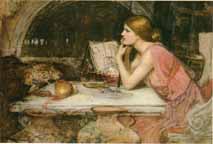
Circe, the sorceress of the island of Aeaea, transforms her victims to animals using a magic herbal drink. In the painting, Circe Offering the Cup to Ulysses, John William Waterhouse depicts the witch in the action of trickery and seduction itself, holding the cup out to Ulysses.
Waterhouse indicates that Circe is in control by positioning her above the eye of the observer; her seat is raised up on a step and she tilts her chin upward so that we must look up into her eyes as she looks down. In this way, Waterhouse manipulates her posture to place her in a position of superiority. In addition, Circe's background indicates power in that the shapes which frame her (the mirror and the arms of her chair) create the effect of a throne.
The painting portrays Circe as a dangerous and beautiful woman. Her dark eyes, hair and lips produce a powerful and frightening demeanor, yet the milky whiteness of her chest and the delicately translucent fabric of her robes indicate her alluring qualities. Indeed, the painting is the ultimate display of her mixed attributes as she holds the cup straight out in front of her in a fearful and yet tempting gesture. Ulysses, on the other hand, is subordinated in the painting — he is merely reflected in the periphery of the mirror, and he bends slightly before Circe as if he is in the midst of bowing or beginning a humble approach to take the ominous cup from her outstretched hand.

By contrast, another painting of Circe by Waterhouse (simply named Circe) presents a more informal image of the witch. Instead of sitting on a throne, Circe occupies a much more domestic position at a table, surrounded by urns. She is informally leaning forward with a book open by her side, as if she is working on her spells in privacy. Her jaw is still strong, yet her lighter hair, soft pink robes and downward gaze onto the table produce a less intimidating effect. In this pose, chin in hand, Circe appears to be quietly contemplating something in the manner of many Pre-Raphaelite ladies.
Questions
1. Looking at the reflection in the mirror in Circe Offering the Cup to Ulysses, Circe appears to be in some sort of temple which is open to the outside. Is this painting claustrophobic?
2. What is Circe holding in her left hand and how does her raised arm contribute to the composition of the painting?
3. Compare Waterhouse's technique in Circe and Circe Offering the Cup to Ulysses.
4. Is it significant that the cup on the table in Circe has been knocked over? What point in the chronology of the story of Circe could this painting depict? Why?
5. Are either of these paintings fantastical? How do they compare with The Crystal Ball?
Last modified 9 December 2006